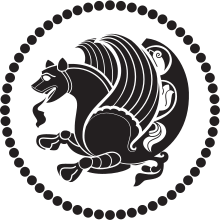
Back سيمرغ Arabic Simurq Azerbaijani Сәмреғош Bashkir Симург Bulgarian Simurgh Catalan Simorq CEB Símurg Czech Семрук CV Simorgh (Mythologie) German Simurğ DIQ
 Simurgh as the royal emblem of the Sassanian Empire[1] | |
| Grouping | Mythical creature |
|---|---|
| Folklore | Persian mythology |
| Country | Ancient Iran |
The simurgh (/sɪˈmɜːrɡ/; Persian: سیمرغ, also spelled senmurv, simorgh, simorg, simurg, simoorg, simorq or simourv) is a benevolent bird in Persian mythology and literature. It bears some similarities with mythological birds from different origins, such as the phoenix (Persian: ققنوس quqnūs) and the humā (Persian: هما).[2] The figure can be found in all periods of Iranian art and literature and is also evident in the iconography of Georgia,[3] medieval Armenia,[4] the Eastern Roman Empire,[5] and other regions that were within the realm of Persian cultural influence.
- ^ Zhivkov, Boris (2015). Khazaria in the Ninth and Tenth Centuries. Brill. p. 78. ISBN 978-9004294486.
- ^ Juan Eduardo Cirlot, A Dictionary of Symbols, Courier Dover Publications, 2002, p. 253
- ^ For example, on the wall of Samtavisi Cathedral
- ^ For example, fresco depiction of simurghs inside medallions (evoking motifs found on Sassanid textiles) in the church of Tigran Honents at Ani. P Donabedian and J. M. Thierry, Armenian Art, New York, 1979, p. 488.
- ^ For example, a row of simurghs are depicted inside the "Ağaçaltı" church in the Ihlara gorge. Thierry, N. and M., Nouvelles églises rupestres de Cappadoce, Paris, 1963, pp. 84–85.